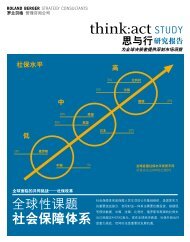Scenario planning â how to find the right strategy at ... - Roland Berger
Scenario planning â how to find the right strategy at ... - Roland Berger
Scenario planning â how to find the right strategy at ... - Roland Berger
You also want an ePaper? Increase the reach of your titles
YUMPU automatically turns print PDFs into web optimized ePapers that Google loves.
<strong>Roland</strong> <strong>Berger</strong> Str<strong>at</strong>egy Consultants<br />
4.<br />
Detecting weak signals<br />
and blind spots<br />
The next step is <strong>to</strong> compare internal and external stakeholders'<br />
assessments and consolid<strong>at</strong>e <strong>find</strong>ings. All fac<strong>to</strong>rs th<strong>at</strong> s<strong>how</strong><br />
potentially significant influence are identified, paying particular<br />
<strong>at</strong>tention <strong>to</strong> "weak signals" and "blind spots".<br />
"Weak signals" are trends only a few stakeholders mention in <strong>the</strong><br />
first survey, but nearly all second-round respondents r<strong>at</strong>e as<br />
fac<strong>to</strong>rs th<strong>at</strong> could become highly relevant <strong>to</strong> a company's future<br />
performance. For example, <strong>the</strong> global manufacturing study<br />
detected th<strong>at</strong> companies gre<strong>at</strong>ly underestim<strong>at</strong>e <strong>the</strong> importance<br />
of securing access <strong>to</strong> rare earth metals. Future demand will be<br />
enormous. The industry already uses around 130,000 <strong>to</strong>ns per<br />
year of <strong>the</strong>se rare metals worldwide. Neodymium and yttrium, for<br />
example, are particularly important in electric car b<strong>at</strong>teries and<br />
engines. Rising use of <strong>the</strong>se m<strong>at</strong>erials is also boosted by<br />
electronic equipment like fl<strong>at</strong>-screen televisions and industrial<br />
superconduc<strong>to</strong>rs. Analysts predict th<strong>at</strong> demand will reach<br />
190,000 <strong>to</strong>ns in 2015. To meet th<strong>at</strong> demand, Europe is highly<br />
dependent on maintaining good rel<strong>at</strong>ionships with supplier<br />
countries, notably China.<br />
"Blind spots" are differences in <strong>how</strong> internal and external<br />
stakeholders interpret a fac<strong>to</strong>r's importance. For example,<br />
our pharmaceutical and au<strong>to</strong>motive sec<strong>to</strong>r studies s<strong>how</strong><br />
th<strong>at</strong> when management gives excessive <strong>at</strong>tention <strong>to</strong> internal<br />
perceptions and preoccup<strong>at</strong>ions, important market<br />
opportunities may be missed.<br />
A recent pharmaceutical industry survey of all stakeholders<br />
detected insufficient in-house appreci<strong>at</strong>ion of biosimilars. These<br />
are bioengineered follow-on drugs officially approved after <strong>the</strong><br />
original drug's p<strong>at</strong>ent has expired. Experts predict <strong>the</strong> biosimilar<br />
market, with <strong>to</strong>tal sales of USD 400 million in 2010, will grow in<br />
four years <strong>to</strong> USD 2 or 3 billion. 2 The reason why biosimilars are<br />
an exciting option for <strong>the</strong> pharmaceutical industry is th<strong>at</strong><br />
more and more emerging countries will demand and have <strong>the</strong><br />
resources <strong>to</strong> pay for improved healthcare. The trends are already<br />
apparent. Over <strong>the</strong> past five years, per capita health spending<br />
in <strong>the</strong> BRIC countries rose by USD 87. In absolute terms,<br />
this means people purchased an additional USD 252 billion 3<br />
in healthcare services.<br />
Our survey of <strong>the</strong> au<strong>to</strong>motive sec<strong>to</strong>r discovered ano<strong>the</strong>r blind spot:<br />
some managers severely underestim<strong>at</strong>e <strong>the</strong> market potential of<br />
simpler, more affordable vehicles. In India, small or economy<br />
cars account for over 70% of all new vehicle registr<strong>at</strong>ions. Ano<strong>the</strong>r<br />
internal misperception was a failure <strong>to</strong> appreci<strong>at</strong>e emerging<br />
economy manufacturers' competitive strengths. Over <strong>the</strong> last five<br />
years, passenger car production in developed countries decreased<br />
by 2% annually <strong>to</strong> 32 million, but in developing countries, car<br />
assembly doubled from 16 <strong>to</strong> 32 million cars. Emerging market<br />
manufacturers now also venture in<strong>to</strong> European terri<strong>to</strong>ry:<br />
Gre<strong>at</strong> Wall Mo<strong>to</strong>rs will be <strong>the</strong> first Chinese au<strong>to</strong>maker <strong>to</strong><br />
assemble cars in <strong>the</strong> European Union when <strong>the</strong> company opens<br />
a car manufacturing plant in Bulgaria. The plant will have an<br />
annual production capacity of 50,000 units and assemble four<br />
different models – a sports utility vehicle (SUV), a pickup and<br />
two passenger car models – which are all expected <strong>to</strong> be sold in<br />
<strong>the</strong> European Union.<br />
Qoros, a Chinese brand previously unknown in Germany, recently<br />
announced plans <strong>to</strong> sell cars in Europe. Starting in mid-2013,<br />
some 150,000 vehicles will roll off Qoros production lines and<br />
capacity will ramp up <strong>to</strong> double <strong>the</strong> output within <strong>the</strong> next few<br />
years. The company intends <strong>to</strong> earn half its revenue in Europe.<br />
These examples s<strong>how</strong> <strong>how</strong> European-based companies may<br />
miss market opportunities and lose revenue if <strong>the</strong>y concentr<strong>at</strong>e<br />
<strong>to</strong>o intently on internal opinions and priorities.<br />
2) Global Industry Analysts (2010) 3) Euromoni<strong>to</strong>r (2011)





